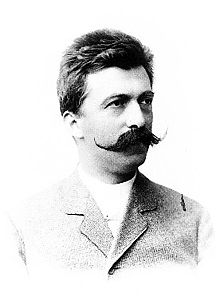Karl Emil Scherz

Karl Emil Scherz (born August 31, 1860 in Loschwitz near Dresden , † October 10, 1945 in Dresden) was a German architect and local writer von Blasewitz .
Life
Scherz was born in Loschwitz in 1860 as the eldest of three children of journeyman bricklayer Carl August Scherz and his wife Christiane Wilhelmine (née Petzold). However, his family moved to Blasewitz just two years later. Scherz attended the Blasewitz village school and the private school of Gustav Moritz Hoffarth and later went to the Dresden trade school . From 1877 to 1881 he studied at the Zittau building trade school under the direction of Hermann Knothe-Seeck and then went on a hike as a carpenter. He did not return to Dresden until 1883 and studied at the Dresden Art Academy with Constantin Lipsius and Ernst Hermann, among others . After graduating as a master builder, a second degree at the Technical University of Charlottenburg followed in 1886 . Scherz opened his own architectural office in Blasewitz in 1889, and in 1908 he was awarded the title of Royal Building Councilor. Scherz stayed in Blasewitz until his death. Here he also held various honorary positions as a councilor, member of the church and school board. Shortly before his death in September 1945, he was made an honorary member of the Saxon Homeland Security Association. His grave is in the Johannisfriedhof in Dresden- Tolkewitz .
Act
As a chronicler
Scherz was heavily involved in a chronicle of the town of Blasewitz and supported the author Otto Gruner. He noted in the foreword of the work Blasewitz published in 1905 : Past, Development and Current Facilities of a Village Community that "the main merit of the creation of the book" was due to a joke.
Scherz himself put on a "local history collection Blasewitz and the surrounding area", in which he combined documents and testimonies. After Blasewitz was incorporated into Dresden in 1921, Scherz saw the purpose of the collection primarily as preserving the history of the independent town of Blasewitz for posterity. In 1986 the collection was transferred to the State Office for the Preservation of Monuments of Saxony in Dresden.
As an architect
Scherz worked as an architect from 1886 to 1921, primarily in the Dresden villa suburbs of Loschwitz and Blasewitz. His total work includes 90 buildings, including 35 residential houses, 24 villas, 4 industrial buildings, a bank building, a warehouse, restaurants and some churches and church conversions, as well as 20 tombs and 28 other projects. The Blasewitz Heilig-Geist-Kirche was one of the architect's first buildings to be of greater importance. The appearance of Blasewitz was largely shaped by its design. For the most important projects, Karl Emil Scherz himself took on the construction management of his buildings, which were mostly built in the historicizing style . When he was confronted with Art Nouveau around 1900 , he began to combine both styles. However, when the architectural zeitgeist broke away completely from historicism with the Bauhaus , Karl Emil Scherz stopped his work.
Building (selection)

- 1886: Villa Goetheallee 6, Blasewitz
- 1888: Landhaus Glasewaldtstrasse 8 in Striesen
- 1891: Reconstruction of the Schillergarten in Blasewitz
- 1891: Lahmanns Sanatorium lodging house , Weißer Hirsch
- 1891–1893: Holy Spirit Church , Blasewitz
- 1892–1898: closed development on Körnerplatz in Loschwitz
- 1892: Körnerplatz 11
- 1895: Körnerplatz 8, Friedrich-Wieck-Straße 2 and 4
- 1897: Körnerplatz 10
- 1898: Körnerplatz 13, Schillerstraße 1, Dammstraße 1
- 1892–1898: closed development on Schillerplatz in Blasewitz
- 1894–1895: Villa von Borcken, Tolkewitzer Strasse 47 in Blasewitz
- 1894–1895: Interior renovation of the Dresden Kreuzkirche
- 1894–1895: Kindergarten Voglerstrasse 2, Blasewitz
- 1894–1895: Villa Justinenstrasse 2, Blasewitz
- 1897: Villa Rothermundt , Blasewitz
- 1898–1899: interior redesign of the Loschwitz church
- 1898–1899: Schubert house , Loschwitzer Strasse 58
- 1899–1901: Assumption Church , Leuben
- 1900–1901: Burenhaus , Silbermannstrasse 22
- 1901–1902: Villa Schmitz, Goetheallee 18, Blasewitz
- 1904–1907: Ehrlichsche Stiftskirche (destroyed)
- 1904 Villa Spengler, Regerstraße 6
- 1905: Extension of the Blasewitz town hall
- 1907: Saxon State High School for Music Carl Maria von Weber , before 2008 Martin-Andersen-Nexö-Gymnasium , Kretschmerstraße 27, Blasewitz
- 1908: Villa Ostermeyer, Barteldesplatz 4, Blasewitz
- 1912: Conversion of the Villa Sebastian-Bach-Straße 17, Blasewitz
Trivia
The State Office for the Preservation of Monuments in Saxony is organizing an annual exhibition from November 14, 2019 to April 3, 2020 in the Ständehaus Dresden , Schloßplatz 1, on the subject of "Karl Emil Scherz (1860-1945). Architect and local chronicle". 226 exhibits from the estate of Karl Emil Scherz are shown.
literature
- Dehio-Handbuch der Deutschen Kunstdenkmäler, Dresden. Updated edition, Deutscher Kunstverlag, Munich / Berlin 2005, ISBN 3-422-03-110-3 , S. #.
- Winfried Werner: Comments on the life and work of Karl Emil Scherz. In: Heilig-Geist-Gemeinde (Hrsg.): 100 years of the Holy Spirit Church in Dresden-Blasewitz. Dresden 1993, pp. 7-10.
- Winfried Werner: Karl Emil Scherz - Blasewitzer architect and local writer . In: Announcements of the Landesverein Sächsischer Heimatschutz eV 2/2016, pp. 11–19
Web links
- Kurt-Dieter Prskawetz: Karl Emil Scherz - architect and local writer from Blasewitz . In: Blasewitzer Zeitung , No. 18 from May 2002.
- Literature by and about Karl Emil Scherz in the Saxon Bibliography
- Flyer for the exhibition 2019/2020 ( online , PDF)
Individual evidence
- ↑ Otto Gruner: Blasewitz: Past, development and current institutions of a village community . Strauch, Leipzig 1905.
- ↑ Werner, p. 9.
- ↑ Media information on the exhibition, ( online , PDF)
| personal data | |
|---|---|
| SURNAME | Joke, Karl Emil |
| BRIEF DESCRIPTION | German architect and local writer |
| DATE OF BIRTH | August 31, 1860 |
| PLACE OF BIRTH | Loschwitz near Dresden |
| DATE OF DEATH | October 10, 1945 |
| Place of death | Dresden |

